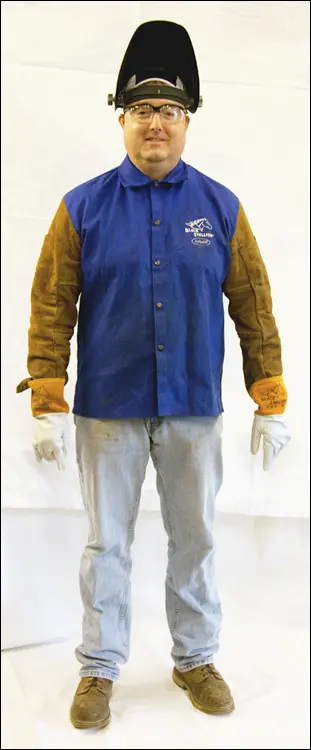Gearing Up to Protect Yourself
A big part of welding safety is making sure you have the right safety equipment on hand for every job, and that’s what I discuss in the following sections. Figure 3-1 shows a welder in full protective gear; make sure you have all these items available before you get going on any welding project.

FIGURE 3-1:A welder wearing recommended safety gear, including ample eye protection.
To protect your eyes from flying debris (usually metal), which you encounter plenty of if you weld regularly, make sure you wear safety glasses in your shop at all times. Make a habit of putting them on as soon as you walk in the door — that way, you’re always protected.
To fully protect your eyes from the damaging effects of ultraviolet welding rays, you need a welding helmet. These helmets protect your eyes (and the rest of your face) from damaging rays, and they include special lenses that allow you to see your work clearly without suffering eye injuries, which I discuss in “ Shielding yourself from burns” later in the chapter. (Check out Figure 3-1 for a look at what a welder with a welding helmet looks like.)
You need to get a helmet appropriate for your particular welding work. New welders often buy helmets that don’t cover all their needs, or purchase ones that are far too heavy duty (and therefore expensive) for the projects they want to do. The following list explains the features of welding helmets that can help you figure out which helmet is right for you:
Shade number: The lenses in welding helmets are rated according to shade number. Shade numbers for welding range from #8 to #14. The higher the shade number, the higher the amperage (the amount of electrical energy flowing through a circuit) you can use when welding without damaging your eyes. Most welding operations are carried out at shade #10, but if you get above 140 amps you must get a darker lens with a shade in the #12 to #14 range.
Auto-darkening or passive lens: Many welding helmets now offer an auto-darkening lens that automatically increases the shade number to account for more-intense welding rays. The alternative is a passive lens, which is the older style of helmet that has a fixed shade number. Auto-darkening helmets are nice because you can see through the lens when you don’t have a live welding arc, so you don’t have to constantly take your helmet off and put it back on when you’re working on a project. However, auto-darkening helmets are much more expensive. Passive lens helmets are cheaper, but you’ll likely have to remove them and put them back on over and over while you’re welding.
Comfort: Make sure you get a helmet with an adjustable headband that feels comfortable on your head and neck. The helmet should stay in place and shouldn’t pinch your head.
 Welding helmets take a lot of abuse, but you don’t have to replace your helmet if it gets nasty or dinged up. You can always repair or replace parts of the helmet (lenses, shields, and headbands for example) instead of emptying your wallet on a new one.
Welding helmets take a lot of abuse, but you don’t have to replace your helmet if it gets nasty or dinged up. You can always repair or replace parts of the helmet (lenses, shields, and headbands for example) instead of emptying your wallet on a new one.
 Sunglasses don’t protect the eyes from welding rays. Don’t even think about using them as eye protection.
Sunglasses don’t protect the eyes from welding rays. Don’t even think about using them as eye protection.
 Make sure you do whatever you can to protect the eyes of others who may be near your welding projects. Ultraviolet welding rays are so powerful that they can penetrate through closed eyelids. If you have bystanders, make sure you say “Cover!” loudly before you strike an arc and get started welding. (You need to let your audience know beforehand what to expect when you say “Cover!”, of course.)
Make sure you do whatever you can to protect the eyes of others who may be near your welding projects. Ultraviolet welding rays are so powerful that they can penetrate through closed eyelids. If you have bystanders, make sure you say “Cover!” loudly before you strike an arc and get started welding. (You need to let your audience know beforehand what to expect when you say “Cover!”, of course.)
Keeping the right fire extinguisher on hand
With all the extreme heat and sparks created during a welding job, you shouldn’t be surprised if something catches fire at some point. Because fires are a very real threat, keep a fire extinguisher on hand at all times.
Four main types of fire extinguishers (shown in Figure 3-2) work on four different kinds of fires:
Class A: Class A extinguishers take care of any fires that produce ash. These fires usually involve wood, cloth, or paper.
Class B: Class B fire extinguishers are for fighting fires caused by flammable liquids, such as gasoline, oils, and paints.
Class C: Electrical fires call for Class C fire extinguishers. Don’t use any water- or foam-based extinguishers on an electric fire, or you put yourself at risk of serious shock.
Class D: Use Class D extinguishers on metal fires. Combustible metals like magnesium, potassium, and sodium are extremely flammable, and fires based on these materials are very dangerous. Class D extinguishers are best for these fires because the other classes often disperse a metal fire instead of putting it out, and that makes the situation worse.
You should keep a Class C extinguisher nearby when you’re welding, in case an electrical fire breaks out. I recommend also keeping a Class B on hand for oil fires.
 In addition to fire extinguishers, keep a water source (a hose, for example) and a bucket of sand nearby when you’re welding. They can come in handy when you need to control ash and metal fires, respectively, without the need for special extinguishers.
In addition to fire extinguishers, keep a water source (a hose, for example) and a bucket of sand nearby when you’re welding. They can come in handy when you need to control ash and metal fires, respectively, without the need for special extinguishers.
 The best way to avoid needing an extinguisher is to cut down on the flammability of your project in the first place. For example, you may find the need to weld a metal 55-gallon drum. (It’s a common welding task.) If so, take care to ensure that the drum doesn’t have residual flammable materials on the interior. Before welding, be sure to clean the interior with steam or a chemical cleaner.
The best way to avoid needing an extinguisher is to cut down on the flammability of your project in the first place. For example, you may find the need to weld a metal 55-gallon drum. (It’s a common welding task.) If so, take care to ensure that the drum doesn’t have residual flammable materials on the interior. Before welding, be sure to clean the interior with steam or a chemical cleaner.

FIGURE 3-2:Four classes of fire extinguishers.
Wearing protective clothing
If you’ve ever thought of yourself getting started on your first welding project wearing a pair of shorts, an old t-shirt, and a pair of flip-flops, think again. If you want to keep your body safe from the hazards of welding — especially burns — you have to always wear appropriate protective clothing.
Welding produces a huge amount of hot metal sparks and flying slag (molten metal). To keep your skin from being burned, choose clothing made from the right material. One of the best options is 100-percent wool, but it can be difficult to find and is extremely hot. (Some people are also allergic to wool.) I prefer 100-percent cotton, and it’s the most popular material used for welding clothing. The fabric should be thick (because welding rays can penetrate thin fabric and burn your skin like a sunburn) and dark-colored; black and dark blue are good options.
Читать дальше


 Welding helmets take a lot of abuse, but you don’t have to replace your helmet if it gets nasty or dinged up. You can always repair or replace parts of the helmet (lenses, shields, and headbands for example) instead of emptying your wallet on a new one.
Welding helmets take a lot of abuse, but you don’t have to replace your helmet if it gets nasty or dinged up. You can always repair or replace parts of the helmet (lenses, shields, and headbands for example) instead of emptying your wallet on a new one. Sunglasses don’t protect the eyes from welding rays. Don’t even think about using them as eye protection.
Sunglasses don’t protect the eyes from welding rays. Don’t even think about using them as eye protection. Make sure you do whatever you can to protect the eyes of others who may be near your welding projects. Ultraviolet welding rays are so powerful that they can penetrate through closed eyelids. If you have bystanders, make sure you say “Cover!” loudly before you strike an arc and get started welding. (You need to let your audience know beforehand what to expect when you say “Cover!”, of course.)
Make sure you do whatever you can to protect the eyes of others who may be near your welding projects. Ultraviolet welding rays are so powerful that they can penetrate through closed eyelids. If you have bystanders, make sure you say “Cover!” loudly before you strike an arc and get started welding. (You need to let your audience know beforehand what to expect when you say “Cover!”, of course.)











